Spatiotemporal Differentiation of Fertilizer and Pesticide Use and Its Driving Factors in the Yangtze River Delta of China: An Analysis at the County Scale
Abstract
1. Introduction
2. Theoretical Framework
3. Materials and Methods
3.1. Study Area
3.2. Variable Selection
3.3. Methods
3.3.1. Mathematical Descriptive Statistical Analysis
3.3.2. Two-Way Fixed Effects Model
3.4. Data Sources
4. Results
4.1. Spatiotemporal Differentiation Characteristics of Fertilizer and Pesticide Use in the YRD
4.1.1. Characteristics of FUI and PUI in Spatial Cross Sections
4.1.2. Characteristics of FUI and PUI in Time Series
4.2. Influence Mechanism of Fertilizer and Pesticide Use Evolution in YRD
5. Discussion
6. Conclusions
Author Contributions
Funding
Data Availability Statement
Acknowledgments
Conflicts of Interest
References
- Pingali, P.L. Green Revolution: Impacts, limits, and the path ahead. Proc. Natl. Acad. Sci. USA 2012, 109, 12302–12308. [Google Scholar] [CrossRef] [PubMed]
- Maaz, T.M.; Sapkota, T.B.; Eagle, A.J.; Kantar, M.B.; Bruulsema, T.W.; Majumdar, K. Meta-analysis of yield and nitrous oxide outcomes for nitrogen management in agriculture. Glob. Change Biol. 2021, 27, 2343–2360. [Google Scholar] [CrossRef]
- Tang, F.H.M.; Lenzen, M.; McBratney, A.; Maggi, F. Risk of pesticide pollution at the global scale. Nat. Geosci. 2021, 14, 206–210. [Google Scholar] [CrossRef]
- Liu, L.; Xu, W.; Lu, X.; Zhong, B.; Guo, Y.; Lu, X.; Zhao, Y.; He, W.; Wang, S.; Zhang, X.; et al. Exploring global changes in agricultural ammonia emissions and their contribution to nitrogen deposition since 1980. Proc. Natl. Acad. Sci. USA 2022, 119, e2121998119. [Google Scholar] [CrossRef]
- Wu, Y.; Xi, X.; Tang, X.; Luo, D.; Gu, B.; Lam, S.K.; Vitousek, P.M.; Chen, D. Policy distortions, farm size, and the overuse of agricultural chemicals in China. Proc. Natl. Acad. Sci. USA 2018, 115, 7010–7015. [Google Scholar] [CrossRef]
- Zhang, Y.; Long, H.; Li, Y.; Ge, D.; Tu, S. How does off-farm work affect chemical fertilizer application? Evidence from China’s mountainous and plain areas. Land Use Policy 2020, 99, 104848. [Google Scholar] [CrossRef]
- Cheng, P.; Tang, H.; Lin, F.; Kong, X. Bibliometrics of the nexus between food security and carbon emissions: Hotspots and trends. Environ. Sci. Pollut. Res. 2023, 30, 25981–25998. [Google Scholar] [CrossRef] [PubMed]
- Zhu, X.; Zhang, Y.; Zhu, Y.; Li, Y. The shift to plant-based dietary patterns in China would have significant effects on cultivated land resources. Sci. Bull. 2024, 69, 737–740. [Google Scholar] [CrossRef] [PubMed]
- Hu, S.; Wang, Y.; Liu, Y. Understanding organic agriculture based on coupled human-earth systems for sustainable land use and rural development in China. Land Use Policy 2025, 152, 107506. [Google Scholar] [CrossRef]
- Campos, B.C.; Qi, X. A literature review on the drivers and barriers of organic food consumption in China. Agric. Food Econ. 2024, 12, 18. [Google Scholar] [CrossRef]
- Jin, S.; Zhang, Z.; Hu, Y.; Du, Z. Historical logic, theoretical interpretation, and practical exploration of China’s agricultural green transformation. Issues Agric. Econ. 2024, 45, 4–19. (In Chinese) [Google Scholar] [CrossRef]
- Gao, J.; Peng, C.; Shi, Q. Study on the high chemical fertilizers consumption and fertilization behavior of small rural household in China: Discovery from 1995–2016 national fixed point survey data. J. Manag. World 2019, 35, 120–132. (In Chinese) [Google Scholar] [CrossRef]
- Zhao, X.; Liu, J.; Wang, R.; Wang, X. Spatial-temporal coupling relationship between chemical fertilizer application and grain yield in China at city scale. J. Nat. Resour. 2019, 34, 1471–1482. (In Chinese) [Google Scholar]
- Pan, X.; Li, P.; Feng, Z.; Duan, C. Spatial and temporal variations in fertilizer use across prefecture-level cities in China from 2000 to 2015. Environ. Sci. 2019, 40, 4733–4742. (In Chinese) [Google Scholar] [CrossRef]
- Zang, Y.; Hu, S.; Liu, Y. Rural transformation and its links to farmland use transition: Theoretical insights and empirical evidence from Jiangsu, China. Habitat Int. 2024, 149, 103094. [Google Scholar] [CrossRef]
- Xin, L.; Li, X.; Tan, M. Temporal and regional variations of China’s fertilizer consumption by crops during 1998–2008. J. Geogr. Sci. 2012, 22, 643–652. [Google Scholar] [CrossRef]
- Snapp, S.; Sapkota, T.B.; Chamberlin, J.; Cox, C.M.; Gameda, S.; Jat, M.L.; Marenya, P.; Mottaleb, K.A.; Negra, C.; Senthilkumar, K.; et al. Spatially differentiated nitrogen supply is key in a global food-fertilizer price crisis. Nat. Sustain. 2023, 6, 1268–1278. [Google Scholar] [CrossRef]
- Zhang, Z.; Yang, Z.; Zhou, J. Agricultural green development pilot zones: With a discussion on the relationship between chemical fertilizer reduction and food security. Chin. J. Agric. Resour. Reg. Plan. 2025, 1–17. Available online: http://kns.cnki.net/kcms/detail/11.3513.S.20250110.1341.022.html (accessed on 26 May 2025). (In Chinese).
- Pan, D.; Kong, F.; Zhang, N.; Ying, R. Knowledge training and the change of fertilizer use intensity: Evidence from wheat farmers in China. J. Environ. Manag. 2017, 197, 130–139. [Google Scholar] [CrossRef]
- Cao, A.; Guo, L.; Li, H. How does land renting-in affect chemical fertilizer use? The mediating role of land scale and land fragmentation. J. Clean. Prod. 2022, 379, 134791. [Google Scholar] [CrossRef]
- Fan, P.; Mishra, A.K.; Feng, S.; Su, M. The effect of agricultural subsidies on chemical fertilizer use: Evidence from a new policy in China. J. Environ. Manag. 2023, 344, 118423. [Google Scholar] [CrossRef] [PubMed]
- Bayramoglu, B.; Chakir, R. The impact of high crop prices on the use of agro-chemical inputs in France: A structural econometric analysis. Land Use Policy 2016, 55, 204–211. [Google Scholar] [CrossRef]
- Xin, L. Chemical fertilizer rate, use efficiency and reduction of cereal crops in China, 1998–2018. J. Geogr. Sci. 2022, 32, 65–78. [Google Scholar] [CrossRef]
- Zhang, Y.; Long, H.; Wang, M.Y.; Li, Y.; Ma, L.; Chen, K.; Zheng, Y.; Jiang, T. The hidden mechanism of chemical fertiliser overuse in rural China. Habitat Int. 2020, 102, 102210. [Google Scholar] [CrossRef]
- Chen, C.; Wu, K.; Chen, J. Evolution of agricultural green development in the Yangtze River Economic Belt based on the perspective of reducing chemical products input and increasing output. J. Nat. Resour. 2024, 39, 2399–2417. (In Chinese) [Google Scholar] [CrossRef]
- Tu, S.; Jian, D.; Long, H.; Li, T.; Zhang, Y. Evolution characteristics and mechanism of major crops production patterns in Guangxi. Acta Geogr. Sin. 2022, 77, 2322–2337. (In Chinese) [Google Scholar]
- Jin, T. The adjustment of China’s grain cropping structure and its effect on the consumption of water and land resources. J. Nat. Resour. 2019, 34, 14–25. (In Chinese) [Google Scholar] [CrossRef]
- Zhang, Y.; Long, H.; Li, Y.; Ma, L. Classification of the coupling patterns between agricultural production system transition and their environmental effects in the plain farming regions. Geogr. Res. 2022, 41, 1623–1636. [Google Scholar]
- Song, X.; Wang, X.; Li, X.; Zhang, W.; Scheffran, J. Policy-oriented versus market-induced: Factors influencing crop diversity across China. Ecol. Econ. 2021, 190, 107184. [Google Scholar] [CrossRef]
- Hu, X.; Li, H.; Zhang, X.; Yuan, Y.; Jia, K. How rent facilitates capital accumulation: A case study of rural land capitalization in Suzhou, China. Land Use Policy 2024, 139, 107063. [Google Scholar] [CrossRef]
- Yuan, Y.; Wang, Y.; Xu, P. Cultivated land use control from the perspective of “non-grain” governance: Response logic and framework construction. J. Nat. Resour. 2024, 39, 942–959. [Google Scholar] [CrossRef]
- Wang, X.; Song, X.; Wang, Y.; Xu, H.; Ma, Z. Understanding the distribution patterns and underlying mechanisms of non-grain use of cultivated land in rural China. J. Rural. Stud. 2024, 106, 103223. [Google Scholar] [CrossRef]
- Zhang, F.; Cui, Z.; Chen, X.; Ju, X.; Shen, J.; Chen, Q.; Liu, X.; Zhang, W.; Mi, G.; Fan, M.; et al. Integrated nutrient management for food security and environmental quality in China. Adv. Agron. 2012, 116, 1–40. [Google Scholar]
- Chen, X.-p.; Cui, Z.; Fan, M.; Vitousek, P.M.; Zhao, M.; Ma, W.; Wang, Z.-l.; Zhang, W.; Yan, X.; Yang, J.; et al. Producing more grain with lower environmental costs. Nature 2014, 514, 486–489. [Google Scholar] [CrossRef]
- Yi, J.; Gerbens-Leenes, P.W.; Aldaya, M.M. Spatial and temporal grey water footprints of agricultural pesticide use: Improved pesticide use options to decrease water pollution in China. Energy Nexus 2024, 16, 100349. [Google Scholar] [CrossRef]
- Zhang, C.; Hu, R.; Shi, G.; Jin, Y.; Robson, M.G.; Huang, X. Overuse or underuse? An observation of pesticide use in China. Sci. Total Environ. 2015, 538, 1–6. [Google Scholar] [CrossRef]
- Caulfield, M.; Bouniol, J.; Fonte, S.J.; Kessler, A. How rural out-migrations drive changes to farm and land management: A case study from the rural Andes. Land Use Policy 2019, 81, 594–603. [Google Scholar] [CrossRef]
- Seufert, V.; Ramankutty, N.; Foley, J.A. Comparing the yields of organic and conventional agriculture. Nature 2012, 485, 229–232. [Google Scholar] [CrossRef]
- Qiu, T.; Choy, S.T.B.; Li, S.; He, Q.; Luo, B. Does land renting-in reduce grain production? Evidence from rural China. Land Use Policy 2020, 90, 104311. [Google Scholar] [CrossRef]
- Zhang, J.; Mishra, A.K.; Hirsch, S. Market-oriented agriculture and farm performance: Evidence from rural China. Food Policy 2021, 100, 102023. [Google Scholar] [CrossRef]
- Chen, C.; Gao, J.; Cao, H.; Chen, W. Unpacking the agricultural innovation and diffusion for modernizing the smallholders in rural China: From the perspective of agricultural innovation system and its governance. J. Rural. Stud. 2024, 110, 103385. [Google Scholar] [CrossRef]
- Xu, D.; Deng, X.; Huang, K.; Liu, Y.; Yong, Z.; Liu, S. Relationships between labor migration and cropland abandonment in rural China from the perspective of village types. Land Use Policy 2019, 88, 104164. [Google Scholar] [CrossRef]
- Tu, Y.; Wu, S.; Chen, B.; Weng, Q.; Bai, Y.; Yang, J.; Yu, L.; Xu, B. A 30 m annual cropland dataset of China from 1986 to 2021. Earth Syst. Sci. Data 2024, 16, 2297–2316. [Google Scholar] [CrossRef]
- Zhang, Y.; Long, H.; Ma, L.; Ge, D.; Tu, S.; Qu, Y. Farmland function evolution in the Huang-Huai-Hai Plain: Processes, patterns and mechanisms. J. Geogr. Sci. 2018, 28, 759–777. [Google Scholar] [CrossRef]
- Zhang, F. Scientific understanding of the role of fertilizers. China Agric. Technol. Ext. 2017, 33, 16–19. (In Chinese) [Google Scholar]
- Yang, J.; Lin, Y. Driving factors of total-factor substitution efficiency of chemical fertilizer input and related environmental regulation policy: A case study of Zhejiang Province. Environ. Pollut. 2020, 263, 114541. [Google Scholar] [CrossRef]
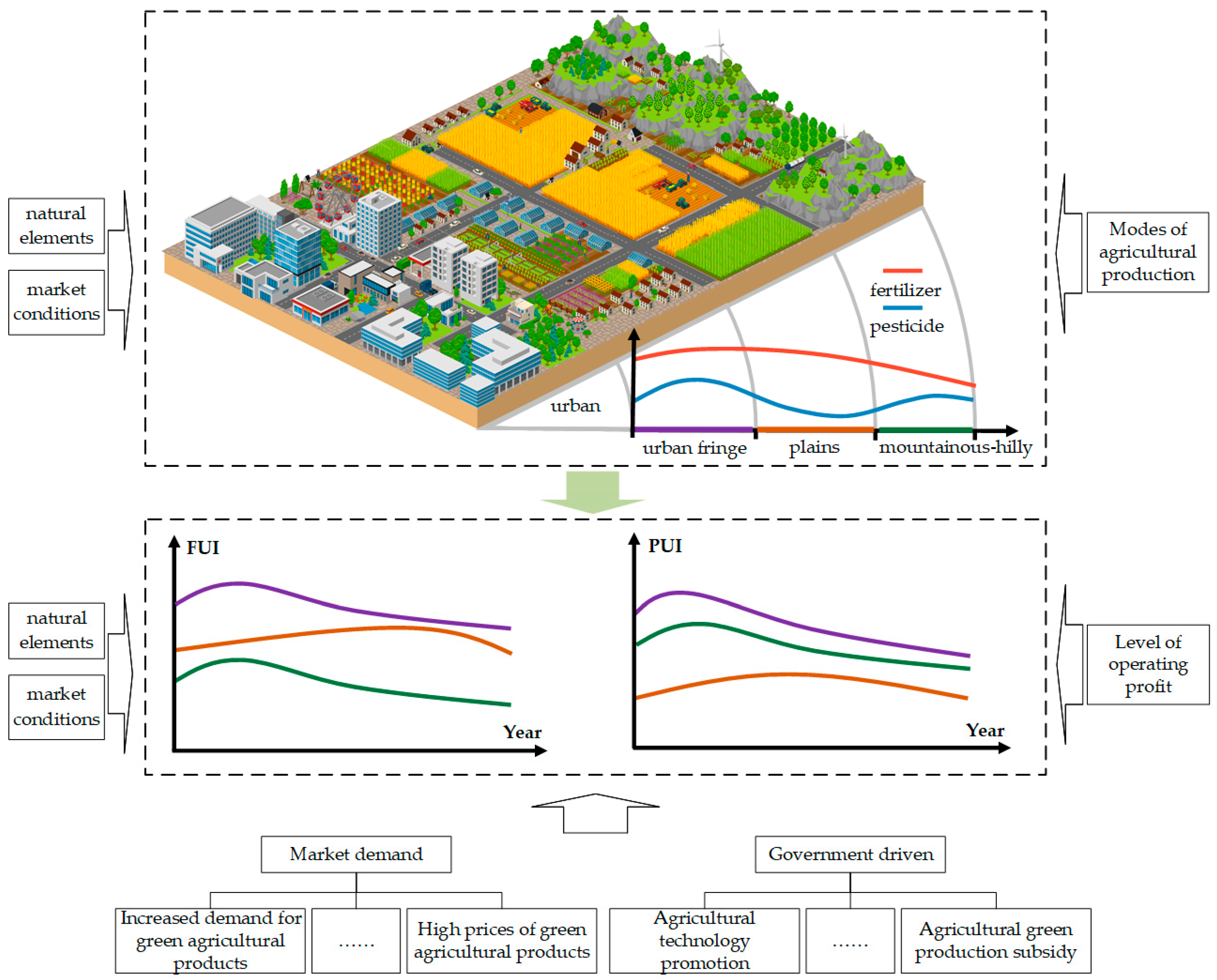
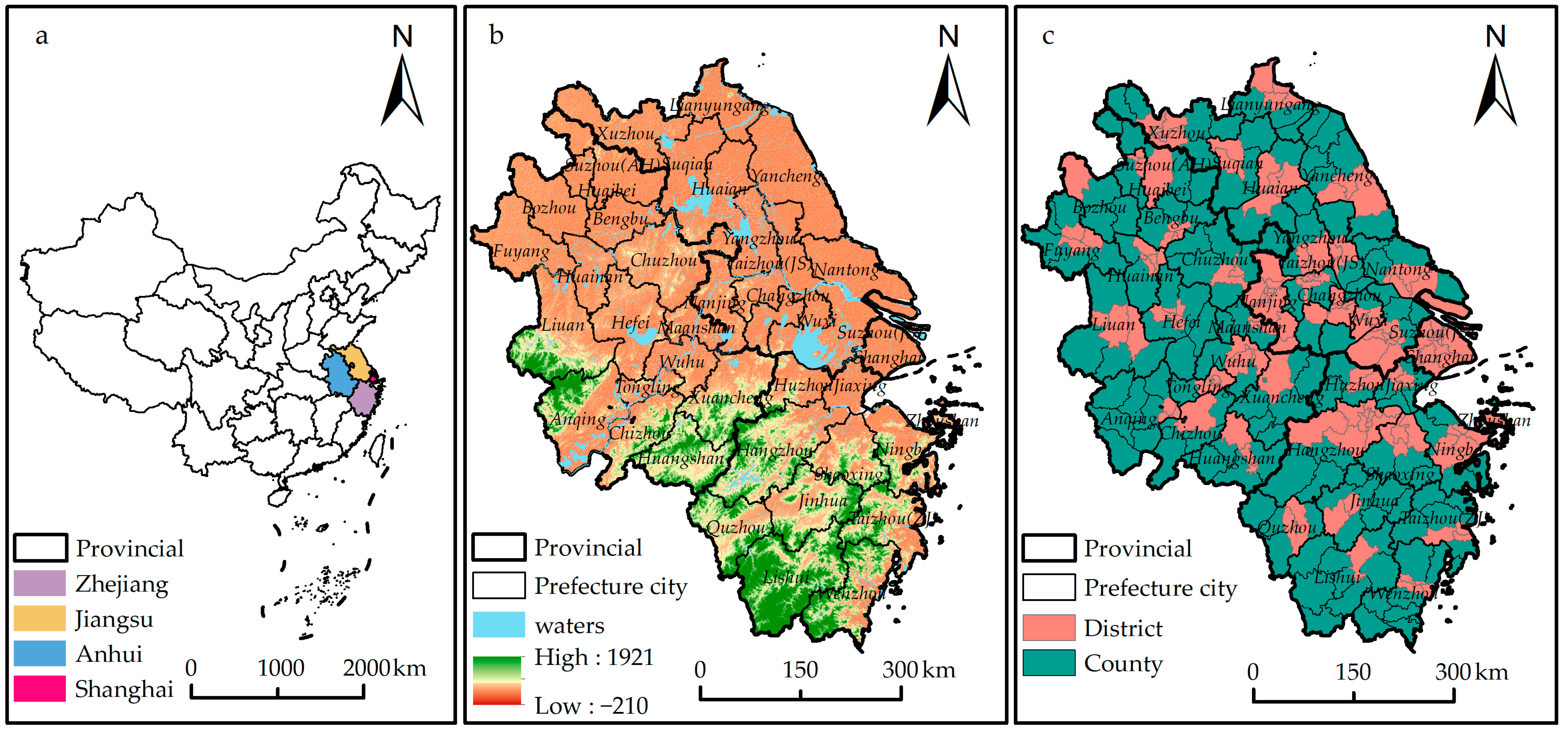

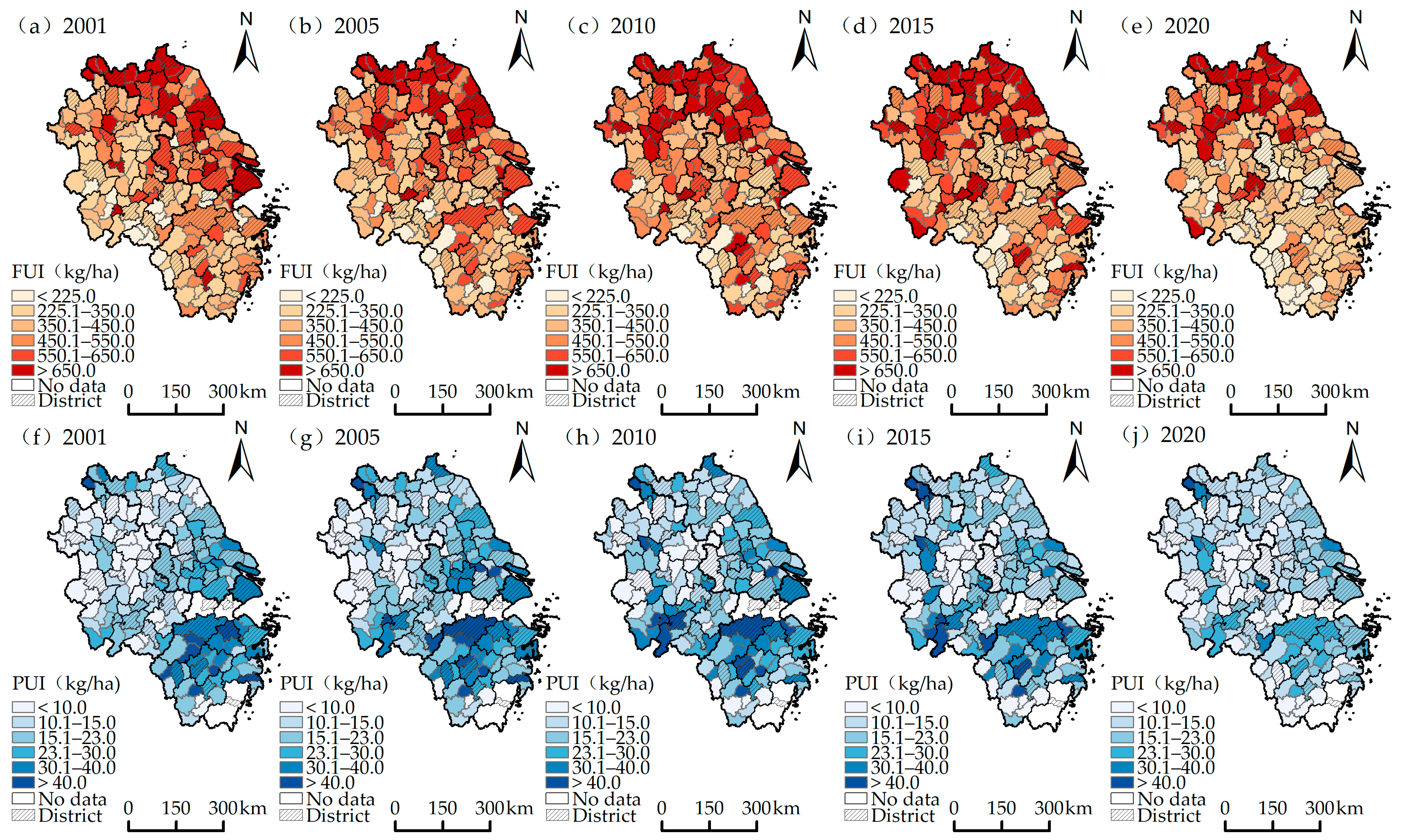
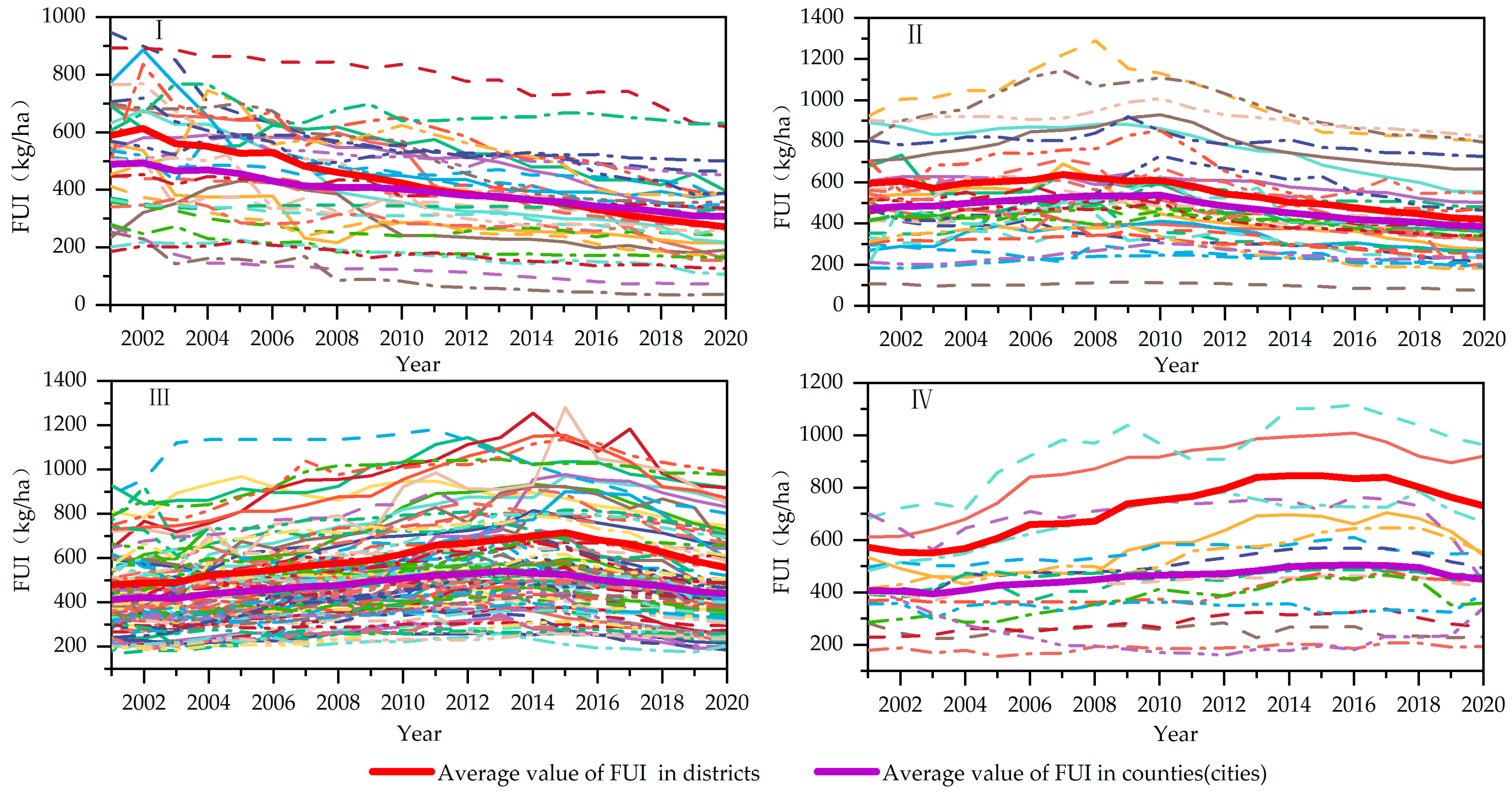
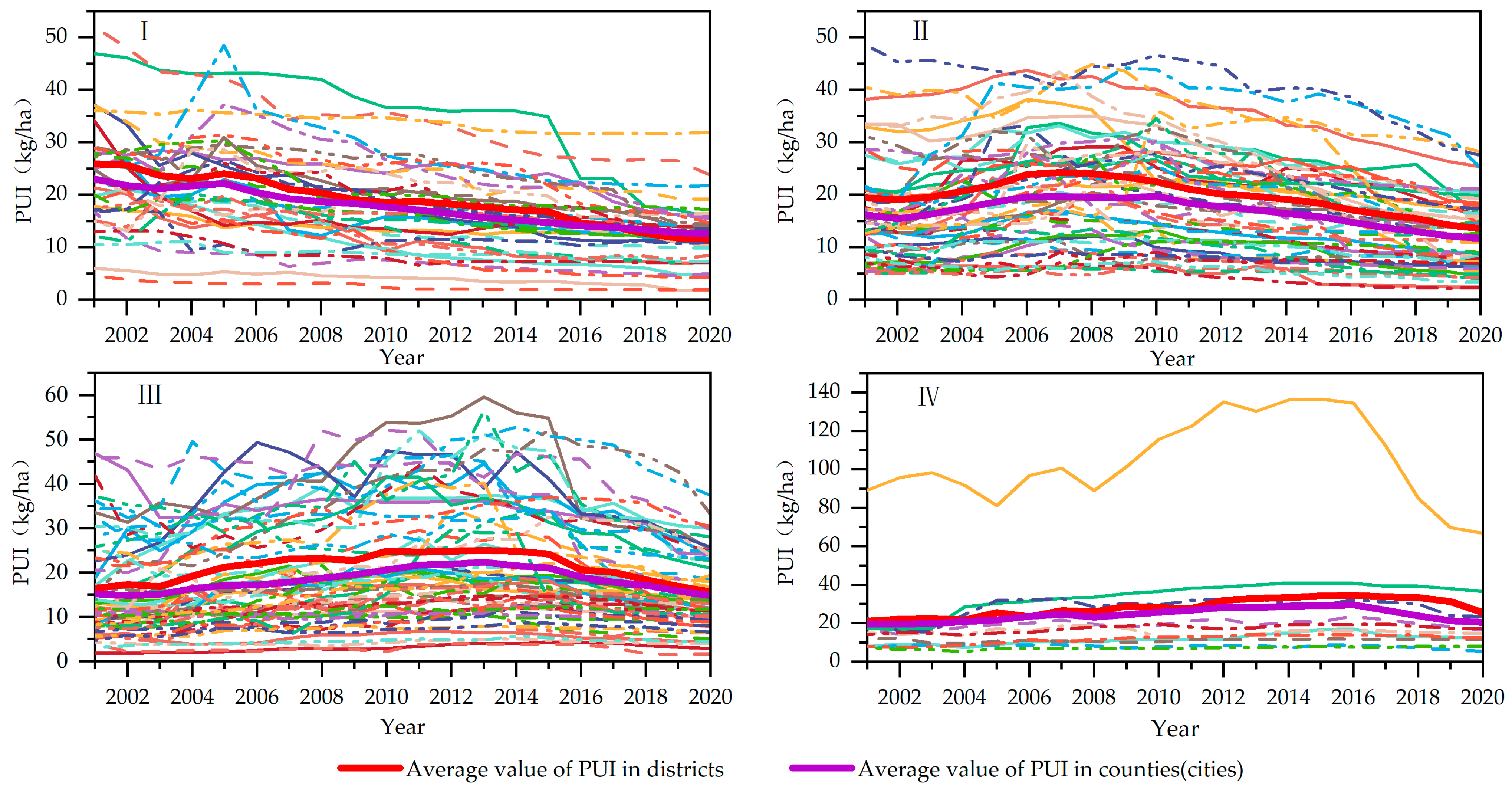

| Variable | Code | Calculation Method | Units | N | Mean | SD | Min | Max |
|---|---|---|---|---|---|---|---|---|
| Fertilizer usage intensity | FUI | Equation (1) | kg/ha | 3780 | 482.80 | 205.68 | 34.99 | 1289.96 |
| Pesticide usage intensity | PUI | Equation (2) | kg/ha | 3420 | 18.60 | 12.38 | 1.60 | 136.69 |
| Elevation | DEM | Average annual elevation by region | m | 3780 | 135.28 | 179.40 | 1.43 | 871.03 |
| Precipitation | PRE | Average annual precipitation by region | mm | 3780 | 1205.86 | 355.72 | 515.77 | 2469.43 |
| Crop type | CT | Grain sowing area/total crop sowing area | % | 3780 | 58.08 | 17.92 | 15.61 | 97.73 |
| Multiple cropping index | MCI | Crop sown area/total farmland area | - | 3780 | 1.49 | 0.29 | 0.23 | 2.71 |
| Economy development level | EDL | Gross regional product/ total population at the end of a year | 10,000 yuan/person | 3780 | 2.79 | 2.22 | 0.19 | 15.09 |
| Fiscal expenditure level | FEL | Fiscal expenditure/total population at the end of a year | 10,000 yuan/person | 3780 | 0.36 | 0.31 | 0.02 | 2.69 |
| Agricultural mechanization level | AML | Total power of agricultural machinery/total farmland area | kw/ha | 3780 | 8.45 | 4.18 | 1.54 | 34.93 |
| Population density | PD | Total population at the end of a year/administrative area | 10,000 persons/ha | 3780 | 5.98 | 4.50 | 0.55 | 38.23 |
| Data | Sources |
|---|---|
| Fertilizer use, pesticide use, crop sown area, crop yield and socio-economic statistics data | The FAO database (https://www.fao.org/faostat/en/#data, accessed on 6 September 2024), statistical yearbooks of provinces (municipality), and their subordinate prefecture-level cities |
| Population data | The fifth to seventh China Population Census data, statistical yearbooks of provinces (municipality) |
| Cultivated land data | Statistical yearbooks, land change survey data, and published papers (CACD) [43] |
| Digital elevation model (DEM) data | NASA DEM global 30 m resolution DEM data (https://www.earthdata.nasa.gov, accessed on 1 May 2024) |
| Precipitation data | National Earth System Science Data Center (http://www.geodata.cn, accessed on 28 October 2024) |
| Administrative divisions data | Standard Map Service System of the Ministry of Natural Resources (http://bzdt.ch.mnr.gov.cn/, accessed on 1 September 2024) |
| Variables | DEM | PRE | CT | MCI | EDL | FEL | AML | PD |
|---|---|---|---|---|---|---|---|---|
| VIF | 2.77 | 2.29 | 1.71 | 1.13 | 3.05 | 2.55 | 1.17 | 1.82 |
| 1/VIF | 0.361 | 0.437 | 0.583 | 0.886 | 0.328 | 0.392 | 0.854 | 0.549 |
| FUI (1–3) | PUI (4–6) | |||||
|---|---|---|---|---|---|---|
| M1 | M2 | M3 | M4 | M5 | M6 | |
| DEM | −0.135 *** | −0.119 *** | −0.058 ** | −0.011 *** | −0.011 *** | −0.009 *** |
| (−5.2967) | (−4.6424) | (−2.1749) | (−6.3143) | (−6.0780) | (−5.0073) | |
| PRE | −0.188 *** | −0.193 *** | −0.192 *** | 0.006 *** | 0.006 *** | 0.006 *** |
| (−14.1022) | (−14.5142) | (−14.4847) | (6.1201) | (5.9634) | (5.8905) | |
| CT | 0.550 *** | 0.839 *** | 0.986 *** | −0.179 *** | −0.170 *** | −0.171 *** |
| (2.6178) | (3.9126) | (4.5945) | (−12.3858) | (−11.5348) | (−11.5738) | |
| MCI | 192.959 *** | 187.806 *** | 172.822 *** | 12.694 *** | 12.523 *** | 11.398 *** |
| (19.1571) | (18.6661) | (16.9533) | (18.3784) | (18.0967) | (16.2687) | |
| EDL | −5.405 *** | 18.846 *** | 9.938 ** | 0.615 *** | 1.469 *** | 0.989 *** |
| (−2.7084) | (4.2085) | (2.1642) | (4.5631) | (4.8042) | (3.1418) | |
| EDL2 | −2.334 *** | −2.062 *** | −0.082 *** | −0.048 * | ||
| (−6.0427) | (−5.3158) | (−3.1113) | (−1.8142) | |||
| FEL | −1.684 | −1.882 | 4.331 | −5.776 *** | −5.804 *** | −4.637 *** |
| (−0.0946) | (−0.1062) | (0.2433) | (−4.7363) | (−4.7650) | (−3.8013) | |
| AML | 2.817 *** | 0.421 *** | ||||
| (3.7268) | (7.9636) | |||||
| PD | 4.901 *** | 0.034 | ||||
| (5.7409) | (0.5232) | |||||
| _cons | 423.889 *** | 380.648 *** | 350.940 *** | 5.301 ** | 3.839 * | 2.163 |
| (14.1307) | (12.3980) | (11.4262) | (2.5387) | (1.7961) | (1.0024) | |
| N | 3780 | 3780 | 3780 | 3420 | 3420 | 3420 |
| Year control | Yes | Yes | Yes | Yes | Yes | Yes |
| Reg control | Yes | Yes | Yes | Yes | Yes | Yes |
| R2 | 0.311 | 0.318 | 0.328 | 0.157 | 0.159 | 0.175 |
| FUI (7–9) | PUI (10–12) | |||||
|---|---|---|---|---|---|---|
| M7 | M8 | M9 | M10 | M11 | M12 | |
| DEM | −0.151 *** | −0.131 *** | −0.056 * | −0.012 *** | −0.012 *** | −0.011 *** |
| (−5.2960) | (−4.5876) | (−1.8614) | (−6.2195) | (−5.8880) | (−5.0222) | |
| PRE | −0.189 *** | −0.195 *** | −0.195 *** | 0.006 *** | 0.006 *** | 0.005 *** |
| (−12.8071) | (−13.2610) | (−13.3361) | (5.5479) | (5.3483) | (5.0177) | |
| CT | 0.559 ** | 0.921 *** | 1.035 *** | −0.198 *** | −0.183 *** | −0.185 *** |
| (2.2596) | (3.6298) | (4.0974) | (−11.4366) | (−10.3308) | (−10.5391) | |
| MCI | 183.116 *** | 178.339 *** | 162.391 *** | 13.754 *** | 13.570 *** | 12.471 *** |
| (15.8975) | (15.5275) | (13.9719) | (17.0920) | (16.8690) | (15.3268) | |
| EDL | −6.663 ** | 22.595 *** | 10.346 * | 0.914 *** | 2.209 *** | 1.595 *** |
| (−2.4578) | (3.9612) | (1.7504) | (4.8829) | (5.5338) | (3.8404) | |
| EDL2 | −3.291 *** | −2.860 *** | −0.144 *** | −0.090 ** | ||
| (−5.8205) | (−5.0268) | (−3.6698) | (−2.2908) | |||
| FEL | 17.028 | 17.637 | 15.137 | −7.416 *** | −7.490 *** | −5.816 *** |
| (0.6212) | (0.6469) | (0.5531) | (−3.8722) | (−3.9194) | (−3.0380) | |
| AML | 1.840 ** | 0.472 *** | ||||
| (2.1599) | (7.8479) | |||||
| PD | 6.391 *** | −0.025 | ||||
| (6.2253) | (−0.3160) | |||||
| _cons | 439.095 *** | 391.183 *** | 371.366 *** | 4.936 ** | 2.863 | 1.733 |
| (13.1070) | (11.3979) | (10.8746) | (2.0844) | (1.1787) | (0.7128) | |
| N | 3024 | 3024 | 3024 | 2736 | 2736 | 2736 |
| Year control | Yes | Yes | Yes | Yes | Yes | Yes |
| Reg control | Yes | Yes | Yes | Yes | Yes | Yes |
| R2_a | 0.287 | 0.295 | 0.306 | 0.172 | 0.176 | 0.194 |
| Municipal Districts | Plains Counties | Mountainous-Hilly Counties | ||||
|---|---|---|---|---|---|---|
| M13 | M14 | M15 | M16 | M17 | M18 | |
| DEM | −0.365 *** | −0.379 *** | −2.487 *** | −2.459 *** | 0.114 *** | 0.118 *** |
| (−3.4791) | (−3.5747) | (−8.7952) | (−8.8073) | (3.6114) | (3.7223) | |
| PRE | −0.071 ** | −0.066 * | −0.301 *** | −0.303 *** | −0.043 * | −0.046 * |
| (−2.1112) | (−1.9401) | (−14.6070) | (−14.8118) | (−1.7233) | (−1.8348) | |
| CT | 2.902 *** | 2.392 *** | −2.138 *** | −2.099 *** | 2.152 *** | 2.237 *** |
| (4.8733) | (4.0402) | (−6.6316) | (−6.6332) | (5.5542) | (5.8244) | |
| MCI | 274.204 *** | 293.361 *** | 113.722 *** | 112.779 *** | 68.626 *** | 66.252 *** |
| (11.5945) | (12.4498) | (6.7179) | (6.6892) | (4.4266) | (4.2903) | |
| EDL | 49.639 *** | −1.227 | −38.865 *** | −35.716 *** | −6.361 | 13.108 *** |
| (3.9687) | (−0.2179) | (−5.6273) | (−7.4584) | (−0.4858) | (2.7254) | |
| EDL2 | −5.268 *** | 0.289 | 2.787 | |||
| (−4.5397) | (0.6329) | (1.5986) | ||||
| FEL | 41.387 | 17.629 | 245.710 *** | 243.695 *** | −105.720 *** | −113.101 *** |
| (1.2880) | (0.5491) | (3.9176) | (3.8912) | (−4.6195) | (−5.0422) | |
| AML | 7.245 *** | 8.140 *** | 5.019 *** | 4.882 *** | 1.149 | 0.829 |
| (3.6344) | (4.0519) | (4.7544) | (4.7259) | (0.8174) | (0.5957) | |
| PD | −3.394 ** | −3.503 *** | 1.947 | 2.161 | 8.235 *** | 7.853 *** |
| (−2.5419) | (−2.5908) | (0.9530) | (1.0733) | (4.1677) | (4.0010) | |
| _cons | −20.332 | 64.068 | 832.644 *** | 828.366 *** | 189.344 *** | 173.736 *** |
| (−0.2776) | (0.8931) | (15.7079) | (15.7584) | (3.8395) | (3.5917) | |
| N | 800 | 800 | 1820 | 1820 | 1160 | 1160 |
| Year control | Yes | Yes | Yes | Yes | Yes | Yes |
| Reg control | Yes | Yes | Yes | Yes | Yes | Yes |
| R2_a | 0.383 | 0.367 | 0.290 | 0.290 | 0.135 | 0.134 |
| Municipal Districts | Plains Counties | Mountainous-Hilly Counties | ||||
|---|---|---|---|---|---|---|
| M19 | M20 | M21 | M22 | M23 | M24 | |
| DEM | 0.017 *** | 0.017 *** | 0.073 *** | 0.075 *** | −0.017 *** | −0.018 *** |
| (3.5763) | (3.5838) | (2.9571) | (3.0906) | (−6.7402) | (−6.8362) | |
| PRE | 0.015 *** | 0.015 *** | −0.002 | −0.002 | 0.009 *** | 0.010 *** |
| (9.9537) | (9.9801) | (−1.4508) | (−1.5412) | (4.3022) | (4.4810) | |
| CT | 0.045 * | 0.029 | −0.172 *** | −0.169 *** | −0.113 *** | −0.120 *** |
| (1.7109) | (1.1099) | (−6.7718) | (−6.7441) | (−3.6095) | (−3.8500) | |
| MCI | 9.585 *** | 10.210 *** | 14.323 *** | 14.232 *** | 8.016 *** | 8.233 *** |
| (9.2560) | (9.9027) | (10.3562) | (10.3404) | (6.3585) | (6.5667) | |
| EDL | 2.121 *** | 0.307 | 0.659 | 0.927 ** | 2.628 ** | 1.069 ** |
| (3.8689) | (1.2109) | (1.1755) | (2.3286) | (2.4081) | (2.5461) | |
| EDL2 | −0.188 *** | 0.025 | −0.221 | |||
| (−3.7227) | (0.6790) | (−1.5473) | ||||
| FEL | 2.661 * | 1.741 | −10.311 ** | −10.486 ** | −2.312 | −1.694 |
| (1.9088) | (1.2579) | (−1.9808) | (−2.0173) | (−1.2168) | (−0.9110) | |
| AML | 1.340 *** | 1.389 *** | 0.115 | 0.101 | 0.341 *** | 0.367 *** |
| (13.3520) | (13.8385) | (1.3604) | (1.2329) | (2.9424) | (3.1992) | |
| PD | 0.283 *** | 0.289 *** | 0.059 | 0.082 | 0.986 *** | 1.027 *** |
| (4.3287) | (4.3747) | (0.3463) | (0.4940) | (4.2295) | (4.4284) | |
| _cons | −34.254 *** | −31.572 *** | 7.321 * | 7.027 * | −3.316 | −2.340 |
| (−10.5389) | (−9.8728) | (1.7324) | (1.6719) | (−0.7889) | (−0.5627) | |
| N | 740 | 740 | 1680 | 1680 | 1000 | 1000 |
| Year control | Yes | Yes | Yes | Yes | Yes | Yes |
| Reg control | Yes | Yes | Yes | Yes | Yes | Yes |
| R2_a | 0.503 | 0.494 | 0.129 | 0.129 | 0.250 | 0.249 |
Disclaimer/Publisher’s Note: The statements, opinions and data contained in all publications are solely those of the individual author(s) and contributor(s) and not of MDPI and/or the editor(s). MDPI and/or the editor(s) disclaim responsibility for any injury to people or property resulting from any ideas, methods, instructions or products referred to in the content. |
© 2025 by the authors. Licensee MDPI, Basel, Switzerland. This article is an open access article distributed under the terms and conditions of the Creative Commons Attribution (CC BY) license (https://creativecommons.org/licenses/by/4.0/).
Share and Cite
Wu, K.; Chen, C. Spatiotemporal Differentiation of Fertilizer and Pesticide Use and Its Driving Factors in the Yangtze River Delta of China: An Analysis at the County Scale. Land 2025, 14, 1180. https://doi.org/10.3390/land14061180
Wu K, Chen C. Spatiotemporal Differentiation of Fertilizer and Pesticide Use and Its Driving Factors in the Yangtze River Delta of China: An Analysis at the County Scale. Land. 2025; 14(6):1180. https://doi.org/10.3390/land14061180
Chicago/Turabian StyleWu, Ke, and Cheng Chen. 2025. "Spatiotemporal Differentiation of Fertilizer and Pesticide Use and Its Driving Factors in the Yangtze River Delta of China: An Analysis at the County Scale" Land 14, no. 6: 1180. https://doi.org/10.3390/land14061180
APA StyleWu, K., & Chen, C. (2025). Spatiotemporal Differentiation of Fertilizer and Pesticide Use and Its Driving Factors in the Yangtze River Delta of China: An Analysis at the County Scale. Land, 14(6), 1180. https://doi.org/10.3390/land14061180





